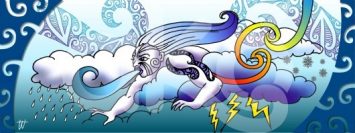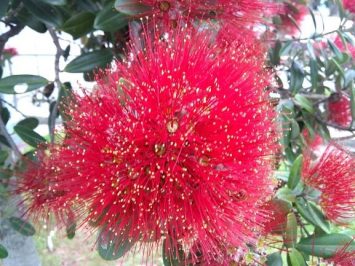Lessons from Aotearoa’s Pōhutukawa in the 2019 International Year of Indigenous Languages and Beyond.
Williams JSE December 2018 General Issue PDF
Link to JSE Fall 2019 General Issue TOC
Abstract: The inspiration for this article came initially from the striking presence of the Pōhutukawa here in Aotearoa during summer combined with the profound experience of undertaking an ancestral journey with my mother along the East Coast, an area of special significance to my iwi (tribe). The journey sparked a number of personal and professional reflections which led to me undertaking some research on the bio-physical and linguistic origins of the Pōhutukawa. This article outlines these as well articulating three principles arising from these reflections which I have continue to apply to my sustainability education endeavours in the 2019 Year of Indigenous Languages and beyond.
Key Words: Indigenous Languages, Sustainability Principles, Māori
Acknowledgement: With special thanks to our Ngāi Te Rangi Elders.
“People not only embed in languages their history, traditions, memory, traditional knowledge, unique modes of thinking, meaning and expression, but more importantly they also construct their future through them”. (UNESCO 2018, p.2).
If you’re in Aotearoa during Raumati (summer) along much of the coast of Te Ika a Māui (the fish of Maui or the North Island) you will see the much beloved Pōhutukawa tree in bloom. Living in the Tauranga Moana (Bay of Plenty) and retracing the footsteps of my Ngāi Te Rangi (Māori tribe) ancestors with my mother around the East Cape this summer, has meant I have kept close company with Pōhutukawa. Growing up on the coast, Pōhutukawa was a constant in my earlier years. Each year the brief but vibrant appearance of her crimson flowers would herald the warmth of raumati. Her woven and twisted roots were mysterious to me as I played in them for many hours at a time each summer. They were also wonderful hiding and contemplation places. As an adult, walking around our maunga (mountain) Mauao or Tīpuna (ancestor) I have also had opportunity to observe how Pōhutukawa supports the nests of Shags and White-faced Herons as they raise their families and dive for fish in the sea below.
Originally growing on rugged coastline (and often volcanic rock!), but gradually also making her way inland to inhabit our forests, Pōhutakawa’s strength and tenacity are deeply embedded in the collective psyche and cultural fabric of those who live in Aotearoa New Zealand today. Magnificent in stature and longevity this tree being can live up to a thousand years. Spending time again in the presence of Pōhutakawa has once more encouraged my curiousness about my relative. I have come to learn much. The opportunities offered to us by the 2019 International Year of Indigenous Languages have shaped some of these reflections; some of which I share with you here.
Early Māori Experiences
For Māori the Indigenous People of Aotearoa, Pōhutukawa is of special significance being regarded as a tapu (sacred) tree or being. Such is her striking beauty (especially when in bloom) that Tauninihi, one of the early Māori navigators, on first sighting Pōhutukawa’s blossoms adorning the trees along the shoreline, threw his sacred chaplet of scarlet amokura (a type of red-tailed tropical bird common to the northern Polynesian Islands) tail feathers overboard, saying he would replace it with “te kura ki uta” — the chaplet on the shore!
Mātauranga Māori (Māori Knowledge)
As time went on Pōhutukawa’s presence was increasingly reflected in the ways of Māori society. Through observation, Māori quickly learned the practical uses of Pōhutukawa. Her flowering is a seasonal sign that kina (sea eggs) are ripe to be harvested from the moana (seas). Rongoā Māori (Māori medicine) recognizes Pōhutukawa’s healing abilities for dysentery, excessive bleeding and for coughs and colds. Spiritually the Pōhutukawa has and continues to hold importance in rituals of death. In former times bodies of Ngāi Te Rangi departed were laid to rest in her ancient bows and roots. The sacred Pōhutukawa on the tip of the wind-swept headland of Te Rerenga Wairua is the departing point for Māori spirits after death as they return to the land of our ancestors, Hawaiiki-a-nui. Te Rerenga Wairua means the ‘leaping off place of spirits and is a place of immense spiritual power. It is located on the northern tip of Te Ika a Māui (the North Island).
Whakapapa (Bio-physical and linguistic Genealogy)
The physical and linguistic variations of Pōhutukawa are threaded and interwoven with each other throughout the Pacific. Her ancestor probably occupied the ‘mobile islands’ of the South West Pacific 55-65 million years ago, making her home in the volcanic or sedimentary rocks as these emerged from the sea. Aotearoa has been important to Pōhutukawa’s origin and subsequent diversification as Tāwhiri-mātea (the wind) carried her seeds across the Pacific seas. (Simpson, 1994). Today her relatives (various adaptations as well as hybridizations) are now found in New Caledonia, the Bonin Islands, Solomon Islands, Vanuatu, Fiji, Samoa, Hawaii and most of the rest of Eastern Polynesia. Throughout parts of Aotearoa such as on the shores of the Rotorua lakes, Pōhutukawa has made her home through adaption, and quite often, hybridization with our native Rata tree, a close relative (Project Crimson, 2016).
For Māori, Pōhutukawa’s name comes from the word “hutukawa” which is a headdress of red feathers – referring to her crimson flowers. “Pō” has many meanings but can refer to the night and in a related sense to a place of departing spirits – the underworld (Simpson, 1994). Linguistically, Pōhutukawa’s closest relative is the Cook Island Māori word po’utukava, referring to a coastal shrub. Exploring her linguistic whakapapa (genealogy) more broadly we begin to see the intricate interconnections between the Indigenous physical and cultural ecologies of the Pacific. Within Proto-Polynesian, the ancestral reconstructed language from which all contemporary Polynesian languages descend (including Māori) Pōhutukawa incorporates the root word hutu or futu which refers to a similar pan tropical tree in other parts of Polynesia, and also the modifier word kawa or kava, one meaning of which is ‘bitter’ (Benton Family Trust, n.d.). These words are found in other Polynesian languages- for example Pacific Island nations such as Samoa, Tonga and Vanuatu, Kava or Kawa refers to a customary drink which is obtained from the bitter Kava or Kawa root.

Figure 2 Tāwhiri-mātea Atua. Credit: Ako Te Reo Learning Resources http://akoresources.co.nz/product/catalogue/atuawall-panels/tawhirimatea-atua-wall-panel
Genealogy and Relationship in the International Year of Indigenous Languages
Today we find ourselves as a large (human) world on a planet burdened with our wants and needs. Human action is now changing the bio-physical functioning of the planet irreversibly (Rockstrōm, et al, 2018). Climate change, the acidification of our oceans, and unequal, and excessive consumption by many, amidst the human ‘disconnect condition’ are the life-threatening issues of our times. Scholars are now writing about the capacity of Indigenous life-ways and languages to heal these intensive effects of colonialism (Whyte, 2017). Through their animation of world-views of interconnectedness in ways which make us more present with our other earth relatives, Indigenous languages are vital to our intergenerational continuity (Williams, 2019). In Te Ao Māori (the Māori world) a good example of this is the word wairere, a Māori word for waterfall. Wai refers to water, whilst rere refers to a range of movements which include to ‘fly, flow, flee, leap,……go into action (any gliding movement), rush, run, race, [and] descend. Rere brings the water to life as an animate being which has a range of movements (Moorefield, 2011). The wai (water) does just not fall but has the capacity for range of movements – i.e., it also flows, leaps, and flies!

Figure 3 The Pōhutukawa orTe Waha-o-Rerekohu, (Te
Araroa, East Cape, Aotearoa); named after the renowned
pataka (food storehouse) that existed by the tree and was
built by chief Rerekohu. The tree is over 350 years old.
The whakapapa of the Pōhutukawa tree is a story of interconnectedness – weaving back and forth between local and distant ecologies of place and language. It is a story of hybridity, adaptation as well as sovereignty as the Pōhutukawa also maintains her integrity as a distinct life form and eco-system. I believe these principals Sovereignty, Adaptation and Hybridity are important at time when Indigenous Languages are not only a human right for Indigenous Peoples, but an ecological imperative for people and planet (UNESCO, 2018). In supporting the survival and revitalization of Indigenous languages, societies and lifeways we need to be thinking and moving towards Indigenous Futures (Williams, 2019) for all societies. The principle of Sovereignty applies to strategies for maintaining the wholeness and integrity of Indigenous languages and lifeways in these turbulent times. Adaptation refers to the necessary evolution of Indigenous languages and mātauranga Māori (Māori knowledge) in-order-to navigate contemporary developments. Hybridity refers to the importance of integrating Indigenous languages in ways that are culturally situated and relevant for those no longer Indigenous to place. Hybrid understandings, meanings and practices between cultural groups may evolve as a result. Vital within these processes will be centring the realities, leadership and worldviews of Indigenous Peoples as the epistemological bedrock of place. Collectively, these principles are important starting points for strategies aimed at actualizing the regenerative potential of Indigenous languages to shape human subjectivities and behaviours in ways that enable the harmonious evolution of people and planet. The evolving lessons and reflections offered by Pōhutukawa this past summer are significant in continuing to guide my practice as a sustainability educator concerned with the enduring links between place, language and people.
References
Benton Family Trust (nd). Te māra reo. The Language Garden: Hutukawa – Pōhutukawa.
Retrieved January 10th 2019, from http://www.temarareo.org
Moorefield, J. (2011). Te Aka: Māori-English, English-Māori dictionary. Wellington, New
Zealand: Longman/Pearson.
Project Crimson (2016). Retrieved 20th December 2018 from https://projectcrimson.org.nz/
Rockstrōm, J., Bai, X., and DeVries, B. (2018). Global sustainability: The challenge ahead.
Global Sustainability, (1), 1-3.
Simpson, P. (1994). Pōhutukawa and bio-diversity. Conservation, Advisory Science Notes.
No. 100. Wellington, New Zealand, Department of Conservation, Retrieved on 4th January 2019 from https://www.doc.govt.nz/documents/science-and-technical/casn100.pdf
UNESCO (2018). Action plan for organizing the 2019 International Year of Indigenous
Languages. Note by the Secretariat. Permanent Forum on Indigenous Issues. Seventeenth session, New York, 16-27th April. Follow up to the recommendations of the Permanent Forum. Retrieved on 18th August 2018 from https://en.iyil2019.org/wp-content/uploads/2018/09/N1804802.pdf
Whyte, K. (2017). Indigenous Climate Change Studies: Indigenizing Futures, Decolonizing
the Anthropocene. English Language Notes, 55(1), 153-162. Retrieved on 9th December 2018 from http://www.muse.jhu.edu/article/711473.
Williams, L. (2019). Re-shaping colonial subjectivities through the language of the land.
Ecopsychology, 11 (3), September. Published online 29th July. https://doi.org/10.1089/eco.2018.0077












 Lewis Williams is a member of the Ngāi Te Rangi iwi (tribe) and lives in the Tauranga Moana, Aotearoa New Zealand. She is the Founding Director of the Alliance for Intergenerational Resilience. Lewis can be contacted at lewis.williams@usask.ca
Lewis Williams is a member of the Ngāi Te Rangi iwi (tribe) and lives in the Tauranga Moana, Aotearoa New Zealand. She is the Founding Director of the Alliance for Intergenerational Resilience. Lewis can be contacted at lewis.williams@usask.ca 
